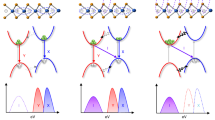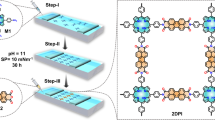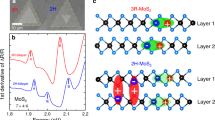Abstract
Van der Waals (vdW) gaps with ångström-scale heights can confine molecules or ions to an ultimately small scale, providing an alternative way to tune material properties and explore microscopic phenomena. Modulation of the height of vdW gaps between two-dimensional (2D) materials is challenging due to the vdW interaction. Here we report a general approach to control the vdW gap by preadsorption of water molecules on the material surface. By controlling the saturation vapour pressure of water vapour, we can precisely control the adsorption level of water molecules and vary the height of the vdW gaps of MoS2 homojunctions from 5.5 Å to 53.6 Å. This technique can be further applied to other homo- and heterojunctions, constructing controlled vdW gaps in 2D artificial superlattices and in 2D/3D and 3D/3D heterojunctions. Engineering the vdW gap has great practical potential to modulate the device performance, as evidenced by the vdW-gap-dependent diode characteristics of the MoS2/gap/MoS2 junction. Our work introduces a general strategy of molecular preadsorption that can extend to various precursors, creating more tunability and variability in vdW material systems.
This is a preview of subscription content, access via your institution
Access options
Access Nature and 54 other Nature Portfolio journals
Get Nature+, our best-value online-access subscription
$29.99 / 30 days
cancel any time
Subscribe to this journal
Receive 12 print issues and online access
$259.00 per year
only $21.58 per issue
Buy this article
- Purchase on Springer Link
- Instant access to full article PDF
Prices may be subject to local taxes which are calculated during checkout




Similar content being viewed by others
Data availability
All the data generated and analysed in this study are included in the Article and its Supplementary Information. The data that support the plots within this paper and other findings of this study are available from the corresponding authors upon reasonable request.
References
Geim, A. K. & Grigorieva, I. V. Van der Waals heterostructures. Nature 499, 419–425 (2013).
Liu, Y., Huang, Y. & Duan, X. Van der Waals integration before and beyond two-dimensional materials. Nature 567, 323–333 (2019).
Huang, X. et al. Recent progress on fabrication and flat-band physics in 2D transition metal dichalcogenides moiré superlattices. J. Semicond. 44, 011901 (2023).
Novoselov, K. S. et al. Two-dimensional atomic crystals. Proc. Natl Acad. Sci. USA 102, 10451–10453 (2005).
Qian, Q. et al. Chiral molecular intercalation superlattices. Nature 606, 902–908 (2022).
Wu, Y., Li, D., Wu, C.-L., Hwang, H. Y. & Cui, Y. Electrostatic gating and intercalation in 2D materials. Nat. Rev. Mater. 8, 41–53 (2023).
Zhao, X. et al. Engineering covalently bonded 2D layered materials by self-intercalation. Nature 581, 171–177 (2020).
Yang, C. et al. Aqueous Li-ion battery enabled by halogen conversion–intercalation chemistry in graphite. Nature 569, 245–250 (2019).
Li, Z. et al. Intercalation strategy in 2D materials for electronics and optoelectronics. Small Methods 5, 2100567 (2021).
Luo, P. et al. Molybdenum disulfide transistors with enlarged van der Waals gaps at their dielectric interface via oxygen accumulation. Nat. Electron. 5, 849–858 (2022).
Geim, A. K. Exploring two-dimensional empty space. Nano Lett. 21, 6356–6358 (2021).
Yang, Q. et al. Capillary condensation under atomic-scale confinement. Nature 588, 250–253 (2020).
Keerthi, A. et al. Ballistic molecular transport through two-dimensional channels. Nature 558, 420–424 (2018).
Radha, B. et al. Molecular transport through capillaries made with atomic-scale precision. Nature 538, 222–225 (2016).
Fumagalli, L. et al. Anomalously low dielectric constant of confined water. Science 360, 1339–1342 (2018).
Gopinadhan, K. et al. Complete steric exclusion of ions and proton transport through confined monolayer water. Science 363, 145–148 (2019).
Yang, Y. et al. Large-area graphene-nanomesh/carbon-nanotube hybrid membranes for ionic and molecular nanofiltration. Science 364, 1057–1062 (2019).
Chen, L. et al. Ion sieving in graphene oxide membranes via cationic control of interlayer spacing. Nature 550, 380–383 (2017).
Abraham, J. et al. Tunable sieving of ions using graphene oxide membranes. Nat. Nanotechnol. 12, 546–550 (2017).
Rajapakse, M. et al. Intercalation as a versatile tool for fabrication, property tuning, and phase transitions in 2D materials. NPJ 2D Mater. Appl. 5, 30 (2021).
Yu, Y. et al. Gate-tunable phase transitions in thin flakes of 1T-TaS2. Nat. Nanotechnol. 10, 270–276 (2015).
Xiong, F. et al. Li intercalation in MoS2: in situ observation of its dynamics and tuning optical and electrical properties. Nano Lett. 15, 6777–6784 (2015).
Wang, C. et al. Monolayer atomic crystal molecular superlattices. Nature 555, 231–236 (2018).
Li, Y., Yan, H., Xu, B., Zhen, L. & Xu, C.-Y. Electrochemical intercalation in atomically thin van der Waals materials for structural phase transition and device applications. Adv. Mater. 33, 2000581 (2021).
Bao, W. et al. Approaching the limits of transparency and conductivity in graphitic materials through lithium intercalation. Nat. Commun. 5, 4224 (2014).
Muñoz-Santiburcio, D. & Marx, D. Confinement-controlled aqueous chemistry within nanometric slit pores. Chem. Rev. 121, 6293–6320 (2021).
Esfandiar, A. et al. Size effect in ion transport through angstrom-scale slits. Science 358, 511–513 (2017).
Kanetani, K. et al. Ca intercalated bilayer graphene as a thinnest limit of superconducting C6Ca. Proc. Natl Acad. Sci. USA 109, 19610–19613 (2012).
Wan, C. et al. Flexible n-type thermoelectric materials by organic intercalation of layered transition metal dichalcogenide TiS2. Nat. Mater. 14, 622–627 (2015).
Friend, R. H. & Yoffe, A. D. Electronic properties of intercalation complexes of the transition metal dichalcogenides. Adv. Phys. 36, 1–94 (1987).
Ruiz-Barragan, S., Muñoz-Santiburcio, D. & Marx, D. Nanoconfined water within graphene slit pores adopts distinct confinement-dependent regimes. J. Phys. Chem. Lett. 10, 329–334 (2019).
Muñoz-Santiburcio, D., Wittekindt, C. & Marx, D. Nanoconfinement effects on hydrated excess protons in layered materials. Nat. Commun. 4, 2349 (2013).
Muñoz-Santiburcio, D. & Marx, D. On the complex structural diffusion of proton holes in nanoconfined alkaline solutions within slit pores. Nat. Commun. 7, 12625 (2016).
Muñoz-Santiburcio, D. & Marx, D. Nanoconfinement in slit pores enhances water self-dissociation. Phys. Rev. Lett. 119, 056002 (2017).
Zang, Y. et al. Flexible suspended gate organic thin-film transistors for ultra-sensitive pressure detection. Nat. Commun. 6, 6269 (2015).
Gong, S. et al. A wearable and highly sensitive pressure sensor with ultrathin gold nanowires. Nat. Commun. 5, 3132 (2014).
Huang, Y.-C. et al. Sensitive pressure sensors based on conductive microstructured air-gap gates and two-dimensional semiconductor transistors. Nat. Electron. 3, 59–69 (2020).
Liu, Y. et al. Approaching the Schottky–Mott limit in van der Waals metal–semiconductor junctions. Nature 557, 696–700 (2018).
Giannozzi, P. et al. QUANTUM ESPRESSO: a modular and open-source software project for quantum simulations of materials. J. Phys. Condens. Matter 21, 395502 (2009).
Acknowledgements
This work was supported by the Strategic Priority Research Program of the Chinese Academy of Sciences (grant number XDB0580000), the National Key Research and Development Program of the Ministry of Science and Technology (grant numbers 2021YFA1200700, 2022YFB4400100), China National Funds for Distinguished Young Scientists Grant 61925403, China National Funds for Outstanding Young Scientists Grant 62122024, the China National Postdoctoral Program for Innovative Talents (grant number BX20230392), the Creative Research Groups Program of the National Natural Science Foundation of China (grant number 62321003), the National Natural Science Foundation of China (grant numbers 91964203, 62134001, 12174094, 62274060, 62311540157), the Natural Science Foundation of Hunan Province (grant numbers 2021RC5004, 2021JJ20028), the Guangdong Basic and Applied Basic Research Foundation–Regional Joint Fund (2020B1515120040), the Shenzhen Science and Technology Research Funding (JCYJ20200109115408041), the Key Research and Development Plan of Hunan Province (grant number 2022WK2001) and the Natural Science Foundation of Changsha (grant number kq2004002).
Author information
Authors and Affiliations
Contributions
X.Z., L.L. and C.L. designed the research. C.L. prepared and characterized a series of vdW gap structures. C.L. and X.Z. performed device fabrication, electrical measurements and analysis. X.L., Y. Liu, C.M., K.L., Y.C. and J.H. participated in the experiment. Y. Lv conducted the DFT calculations and wrote the related discussions. C.L., X.Z, Y. Lv, L.L. and J.H. co-wrote the manuscript with inputs from all of the authors. All authors discussed the results and commented on the manuscript.
Corresponding authors
Ethics declarations
Competing interests
The authors declare no competing interests.
Peer review
Peer review information
Nature Nanotechnology thanks Simon Fleischmann and the other, anonymous, reviewer(s) for their contribution to the peer review of this work.
Additional information
Publisher’s note Springer Nature remains neutral with regard to jurisdictional claims in published maps and institutional affiliations.
Extended data
Extended Data Fig. 1 Schematics depicting the generation and control of SVP.
a, Schematic diagram of the SVP controlling apparatus. In the N2-filled glove box, a PTFE bottle containing 4/5 UP-water with a hole in the top is heated by water bath. Since the experiments are performed in the glove box, the water bath is simply replaced by a beaker filled with water and a hot plate. b, Side view of the SVP generation apparatus. The horizontal line of the water bath is as close as possible to the top of the PTFE bottle to ensure that the gas and liquid inside the PTFE bottle are at the same temperature. When the system reaches stability at a specific temperature, the sample on the substrate (PDMS substrate) is fixed to the hole in the PTFE cap. At the same time, the PTFE bottle is sealed and the material underneath is in a saturated vapor state. Therefore, the required SVP can be precisely controlled by controlling the temperature of water bath. c, The correspondence between SVP and temperature. The SVP at different temperature can be calculated using the Antoni equation: lgP = A – (B / (t + C), here, P represents the SVP in kPa, t represents the temperature of the liquid in °C, and A, B and C are constants. For UP-water, the values of A, B, and C are 7.07, 1657.46 and 227.02, respectively.
Extended Data Fig. 2 Dynamic evolution of water molecule adsorption at 80 °C and 100 °C.
a,b, AFM images of MoS2 surface after at 80 °C for 10 mins (a) and 100 °C for 10 mins (b). Below: height profiles corresponding to the water islands on the AFM images, here the heights of water islands increase with temperature, indicating the feasibility of SVP to control the adsorption level.
Extended Data Fig. 3 The calculated vdW energy between water molecule and MoS2 by DFT.
a, Water molecule on defect-free MoS2 surface. b, Water molecule on defective MoS2 surface (missing an S atom).
Extended Data Fig. 4 Single-layer and multilayer MoS2 stacked gap structures and related analysis.
a-c, Optical micrographs of top single-layer MoS2 (a), bottom multilayer MoS2 (b) and vdW gap structure (c) assembled at Teva = 100 °C. d, AFM image of the surface of single-layer gap structure, where a large number of water droplets are confined and visible due to the high flexibility of the single-layer MoS2. e,f Schematic of the single-layer (e) and multilayer (f) MoS2 gap structure. g, The surface AFM images of different thickness stacking, including the 3-layer, 6-layer and 12-layer MoS2, showing that multilayer stacking is able to form flat surfaces due to the hardness of the multilayer material. h, Low magnification STEM image of the top 12-layer MoS2 gap structure, showing that multilayer stacking is capable of creating large-sized and atomically flat gaps.
Extended Data Fig. 5 AFM and STEM studies to demonstrate thermal stability of gap structures.
a, Edge information of gap structures (assembled at Teva = 100 °C) traced by AFM at different annealing temperatures. Below 90 °C, the water gap can be maintained, while at 250 °C, the edge of the gap completely collapses. b, STEM image of a gap structure with collapsed edges due to high temperature annealing. c, Schematic illustration of the edge collapse process of a gap structure. d, Schematic demonstrating the high temperature stability of an h-BN pre-packaged gap structure. e, Height variations in the h-BN pre-packaged gap structure traced with AFM, and here the pre-packaged gap structure is able to remain structurally stable even at 250 °C annealing. The yellow shading in (a,e) defines the AFM scan region (in the corresponding inset).
Extended Data Fig. 6 The vdW gap structure of diverse building blocks and dimensions prepared by vdW gap engineering.
We show that vdW gap engineering is able to be applied to different materials and different dimensions, including 2D/2D homojunction (such as Graphene/Graphene, PdSe2/PdSe2, and MoTe2/MoTe2), 2D/2D heterojunctions including p–n junctions and semimetal-semiconductor junctions (such as WS2/MoS2, PtS2/MoS2, ReS2/MoS2, WSe2/MoS2 and PdSe2/MoS2), even beyond 2D system including 2D/3D and 3D/3D metal-semiconductor junctions (such as Au/MoS2 and Au/P+Si). The M-S junctions are defined as metal/semiconductor junctions. All the scale bars, 5 nm.
Extended Data Fig. 7 Low-magnification STEM images to demonstrate the homogeneity of the vdW gaps.
Here, all obtained vdW gap structures can be highly consistent over the micrometer length range.
Extended Data Fig. 8 Elemental analysis of gaps in cross-sections prepared by FIB.
a, FIB process for preparing cross-sectional slices. The slices are ultimately thinned to less than 100 nm for subsequent STEM observations. b,c, EDS elemental maps of the cross-sections of a MoS2/gap/MoS2 structure (b) and a PtS2/gap/MoS2 structure (c), where a significant amount of Si elements are found in the gaps in both structures. d, STEM image and elemental analysis of a Graphene/gap/Graphene structure, where the re-deposited amorphous-Si in the gap can be directly seen due to the close Z-contrast (related to atomic-number) of C and Si (in HAADF-STEM). e, STEM image and elemental analysis of a P+Si/gap/Au structure, here, the re-deposited Si in the gap can also be seen. f, EDS energy spectra corresponding to the four gaps above.
Extended Data Fig. 9 Schematics related to droplet gap structure and transport, as well as polarization analysis of defect sites.
a, Schematic explaining the water droplet gap, where the gap is alternately filled with N2 and water droplets. b, The 2 × 2 MoS2 supercell model and the in-x-y-plane potential on its top where an S vacancy (S-vac.) exists. c, Variation of polarization potential of water molecules on MoS2 surface without and with S-vacancy defects calculated by DFT. d, Polarization-potential-difference in the vertical direction of the MoS2/H2O model without and with S-vac. defects.
Extended Data Fig. 10 MoS2/gap/MoS2 diodes for pressure sensing.
a-d, Sound response characteristics of MoS2/gap/MoS2 diodes with different gap height at the voltage of −1 V, including ~1.3 nm gap (a), ~3.9 nm gap (b), ~4.8 nm gap (c) and ~5.3 nm gap (d). Inset of (a): schematic of MoS2/gap/MoS2 structure for pressure sensing test, and a computer-controlled speaker served as an acoustic source instead of the z-motor for obtaining smaller and higher frequency pressures. For a continuous steady electronic-drum-sound pulse (~91 dB), device with maximum gap height (~5.3 nm) shows the most significant and stable response. e, Current response of ~5.3 nm gap device for specific 10 kHz sound waves (~94 dB), highlighting the fast response of our devices (<25 μs, limited by our measurement set-up). f, Pressure sensitivity to the acoustic wave with different frequencies (300–10,000 Hz). g, Pressure response in ultralow pressure range (<1 Pa). Here, the device is consistently sensitive to different pressures with an average sensitivity Save of ~3.9 × 103 kPa−1. h, Repeated test on musical sound waves, demonstrating the stability of the device under rapidly changing pressure. i, Discrimination of human speech sounds, for example, "Standing on the shoulders of giants" and "The important thing is not to stop questioning".
Supplementary information
Supplementary Information
Supplementary Discussions 1–5, Notes 1–6 and Figs. 1–16.
Rights and permissions
Springer Nature or its licensor (e.g. a society or other partner) holds exclusive rights to this article under a publishing agreement with the author(s) or other rightsholder(s); author self-archiving of the accepted manuscript version of this article is solely governed by the terms of such publishing agreement and applicable law.
About this article
Cite this article
Liu, C., Zou, X., Lv, Y. et al. Controllable van der Waals gaps by water adsorption. Nat. Nanotechnol. 19, 448–454 (2024). https://doi.org/10.1038/s41565-023-01579-w
Received:
Accepted:
Published:
Issue Date:
DOI: https://doi.org/10.1038/s41565-023-01579-w



